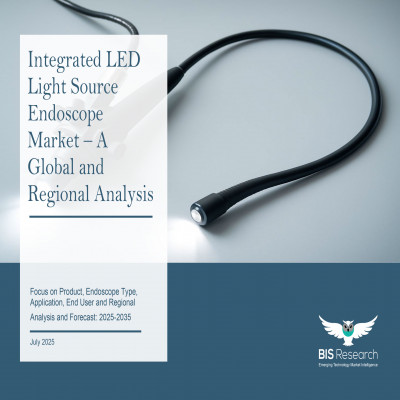Introduction to APAC Integrated LED Light Source Endoscope Market
The Asia-Pacific integrated LED light source endoscope market is projected to reach $907.4 million by 2035 from $127.2 million in 2024, growing at a CAGR of 17.91% during the forecast period 2025-2035. The APAC integrated LED light source endoscope market is expanding at a robust, nearly double-digit rate because to the growing incidence of chronic illnesses, ongoing improvements in light source technology, and the aging population. The adoption of modern endoscopic procedures by healthcare providers around the region is driving up demand.
Surgeons can execute minimally invasive procedures with clear, high-quality visualization of inside organs thanks to light sources, which are an essential component of endoscopic systems. LED-based integrated light sources offer better brightness, a longer lifespan, lower heat emissions, and more energy efficiency than conventional xenon or halogen alternatives. This change is revolutionizing the APAC market.
These developments reinforce patient safety, increase procedure efficiency, decrease long-term operating costs, improve diagnostic accuracy, and improve picture quality. With improvements in lighting technology emerging as a major driver of the market's growth, integrated LED systems are thus playing a crucial part in renovating hospitals and surgical centers throughout APAC.
Market Introduction
The market for integrated LED light source endoscopes in Asia-Pacific is expanding at a faster rate thanks to the expansion of healthcare infrastructure, the growing popularity of minimally invasive procedures, and growing awareness of cutting-edge endoscopic technology. For precise internal organ visualization during diagnostic and therapeutic procedures, integrated LED light sources are essential for providing bright, steady illumination. Longer operational life, lower heat output, lower energy consumption, and improved picture quality are all benefits of LED-based systems over conventional xenon or halogen light sources. These benefits are particularly appealing to APAC healthcare providers looking for dependable and reasonably priced solutions.
The market's growth is supported by an increasing burden of chronic diseases such as gastrointestinal, respiratory, and urological disorders, as well as an aging population in countries such as Japan, China, South Korea, and Australia. The region's regulatory frameworks differ greatly from one another; developed economies like Australia and Japan have strict, established standards, while rising countries like India, Indonesia, and Vietnam have dynamic device clearance procedures. Different markets have different reimbursement schemes; some provide full or partial coverage for endoscopic procedures, while others mostly rely on out-of-pocket expenses. APAC is seeing a steady uptake of integrated LED light source endoscopes due to a number of causes, including growing government spending on healthcare modernization, growing networks of private hospitals, and the need for improved infection control.
Market Segmentation
Segmentation 1: by Endoscope Type
• Single-Use Endoscope
• Reusable Endoscope
Segmentation 2: by Region
• Asia-Pacific
o China
o Japan
o India
o Australia
o South Korea
o Rest-of-Asia Pacific
APAC Integrated LED Light Source Endoscope Market Trend, Drivers and Challenges-
Market Trends
• Strong shift toward LED-based integrated light sources for enhanced illumination, durability, and lower operational costs compared to xenon systems.
• Growing penetration of single-use/disposable endoscopes in infection-sensitive environments, particularly post-COVID-19.
• Increasing integration of high-definition imaging, 4K, and AI-assisted visualization in endoscopic platforms.
• Rising adoption of compact, portable endoscopy units to meet demand in rural and underserved areas.
• Expansion of private hospital chains and specialty clinics across emerging economies in APAC.
Key Growth Drivers
• Rising prevalence of gastrointestinal, respiratory, and urological diseases requiring regular endoscopic diagnosis and treatment.
• Rapid healthcare infrastructure development in emerging economies such as India, Vietnam, and Indonesia.
• Government healthcare modernization initiatives and higher public investment in advanced medical technologies.
• Cost advantages of LED systems due to longer life span, lower maintenance, and reduced energy consumption.
• Increasing geriatric population, particularly in Japan, South Korea, and China, leading to higher endoscopy volumes.
Market Challenges
• Regulatory diversity across APAC, with varying medical device approval processes slowing uniform market entry.
• Limited reimbursement coverage in several emerging markets, leading to high out-of-pocket costs for patients.
• Shortage of skilled endoscopy professionals, particularly in rural and remote areas.
• Price sensitivity in lower-income economies, creating barriers for adoption of advanced integrated LED systems.
• Intense competition from low-cost regional manufacturers, impacting pricing and margins.

